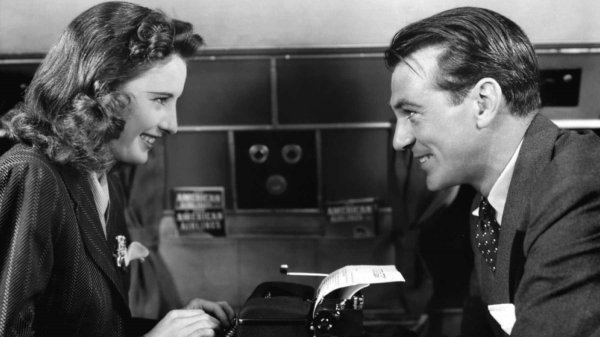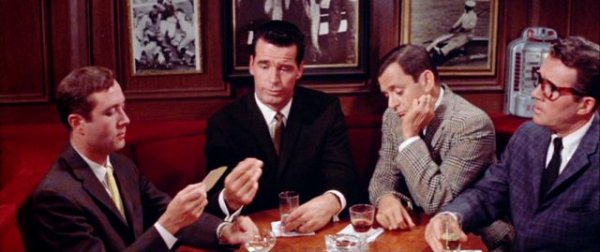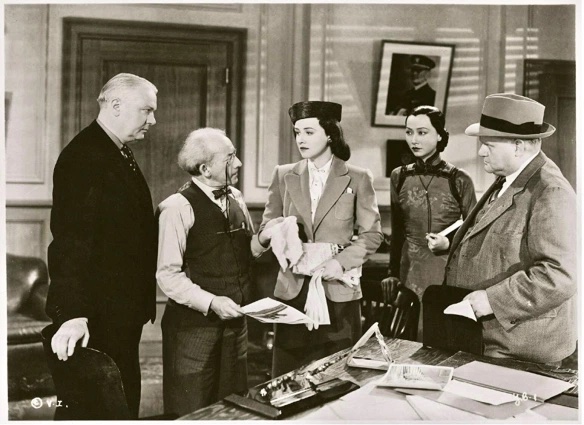LizzieMaine
Bartender
- Messages
- 34,113
- Location
- Where The Tourists Meet The Sea
"Hallelujah, I'm a Bum!" (1933), with Al Jolson, Frank Morgan, Madge Evans and Harry Langdon.

Asa Yoelson is a performer you either enjoy or you absolutely can't stand -- even aside from the cultural baggage of blackface (which he does not don at any point in this film), the Jolson performing style, all bombast and big gestures, is an acquired taste that's very difficult for people to acquire the further we move from the 1910s-1920s Broadway milieu that created it. But if you understand Jolson's place in theatrical history and can contextualize that, he's still a very interesting performer to watch. And never is that more true than in this strange, could-only-have-been-made-when-it-was picture.
In the fall of 1932, when this independent film was made by director Lewis Milestone, unemployment in the United States stood at 25 percent. Millions of once-middle-class people found themselves reduced to complete poverty for reasons they could only dimly understand, and "Hoovervilles," shantytowns full of unemployed and desperate people, bloomed all over the country. One of the largest metastasized in Central Park, and that's where much of the story is set. That's where Jolson as "Bumper," jaunty fellow in a dirty white suit, black turtleneck sweater, and bashed-up hat, presides over his fellow hoboes as "The Mayor of Central Park," a charismatic vagrant who is also a good friend and advisor of the city's mayor -- Frank Morgan as "Johnny Hastings," a bon-vivant type of fellow who's as close to Jimmie Walker as they could get without rousing the lawyers. Johnny slips Bumper cash whenever they meet, and Bumper dispenses philosophy and advice, which seems to both parties to be a fair trade.
Back in Central Park, Bumper's closest friends are an odd and rather engaging pair of characters. Diminutive veteran of Black vaudeville Edgar Connor is Jolson's chipper sidekick "Acorn," and silent-screen comedy genius Harry Langdon is "Egghead," a Communist garbage collector who constantly proclaims revolutionary slogans when he isn't picking up discarded newspapers for Bumper to read over breakfast. I keep waiting for Connor to go into his act, whatever that act was, but, frustratingly, he doesn't -- although Acorn's relationship with Bumper has a friendly cross-racial ease that's not commonly seen in thirties movies. And while Langdon is playing a figure not quite entirely removed from his familiar silent-screen character, he's quite good with what he's given to do. My only regret is that he doesn't get to sing or dance a solo number, because he was quite good at both.
Speaking of music, Bumper has a tendency to burst into song at the slightest provocation, but the songs into which he bursts are by Rodgers and Hart, so this habit is one strongly to be encouraged. He and the rest of the cast also shift without warning from time to time into rhythmic, rhyming dialogue, giving the whole picture the feeling of an experimental vernacular opera, which is definitely not the type of production moviegoers expected in 1933 when they saw Jolson's name on a marquee. This isn't a run of the mill movie musical by any means. It's not quite an operetta, and it's not quite an opera either, but it has elements of all three, combined in a way unlike anything you've ever seen. And Milestone even throws in a few expressionistic montages to give the film an unexpected visual kick lacking in most Hollywood product since talkies came in.
Into all of this unreality drops Madge Evans, as Mayor Johnny's lover -- who in a fit of depression after he accuses her of infidelity attempts suicide by hurling herself in a Central Park lake. Bumper, of course, leaps to her rescue, pulls her out, and finds that she has emerged from the water with a case of amnesia. They fall in love, and Bumper determines to change his ways to be worthy of her -- prevailing upon his pal Mayor Johnny to get him, and Acorn, jobs in a bank. And all is delight -- until the inevitable tragic ending.
Jolson has always been considered, pardon the expression, a supreme example of a ham actor. But his work here, when his whole fragile world comes crashing down in the space of a few minutes, is nothing short of heartbreaking and wonderful. As we fade out, he's sprawled on a treetrunk in the park, clothes in disarray, clearly having gone on a drunken binge, with nothing left but his friends to attend to him. But those friends are smiling, glad to welcome him back.
What's the message here? I don't know if there really is one. Bumper starts out a bum, and he ends up as a bum agai, and you get the sense that this is what he really wanted all along. There's plenty of hard-hitting critique of the Depression in the film, but when most of it is being delivered by Harry Langdon, it's easy not to take it seriously. And Mayor Johnny, who, it is hinted, may not be entirely on the up-and-up, waltzes off with a happy ending. It may be the oddly-contradictory politics that caused the film to flop, or the confusion of genres between musical, operetta, comedy, and melodrama, or it may just be that filmgoers were sick of Jolson, who was all over the screen from 1927-31. Whatever it was, the picture was indifferently received at the box office, and Jolson's movie career went into a brief limbo. And nobody ever tried to make a movie like "Hallelujah, I'm A Bum" ever again.
I still don't know what I think of this film, but I do think about it, which maybe is all we have a right to expect of any picture. But I do go away from it with a real sense of appreciation for Jolson the actor -- I don't think anybody else in the business in 1932 could have done what he did with this role, and while it's just a footnote to a very long career, it's still worthy of being remembered.
Asa Yoelson is a performer you either enjoy or you absolutely can't stand -- even aside from the cultural baggage of blackface (which he does not don at any point in this film), the Jolson performing style, all bombast and big gestures, is an acquired taste that's very difficult for people to acquire the further we move from the 1910s-1920s Broadway milieu that created it. But if you understand Jolson's place in theatrical history and can contextualize that, he's still a very interesting performer to watch. And never is that more true than in this strange, could-only-have-been-made-when-it-was picture.
In the fall of 1932, when this independent film was made by director Lewis Milestone, unemployment in the United States stood at 25 percent. Millions of once-middle-class people found themselves reduced to complete poverty for reasons they could only dimly understand, and "Hoovervilles," shantytowns full of unemployed and desperate people, bloomed all over the country. One of the largest metastasized in Central Park, and that's where much of the story is set. That's where Jolson as "Bumper," jaunty fellow in a dirty white suit, black turtleneck sweater, and bashed-up hat, presides over his fellow hoboes as "The Mayor of Central Park," a charismatic vagrant who is also a good friend and advisor of the city's mayor -- Frank Morgan as "Johnny Hastings," a bon-vivant type of fellow who's as close to Jimmie Walker as they could get without rousing the lawyers. Johnny slips Bumper cash whenever they meet, and Bumper dispenses philosophy and advice, which seems to both parties to be a fair trade.
Back in Central Park, Bumper's closest friends are an odd and rather engaging pair of characters. Diminutive veteran of Black vaudeville Edgar Connor is Jolson's chipper sidekick "Acorn," and silent-screen comedy genius Harry Langdon is "Egghead," a Communist garbage collector who constantly proclaims revolutionary slogans when he isn't picking up discarded newspapers for Bumper to read over breakfast. I keep waiting for Connor to go into his act, whatever that act was, but, frustratingly, he doesn't -- although Acorn's relationship with Bumper has a friendly cross-racial ease that's not commonly seen in thirties movies. And while Langdon is playing a figure not quite entirely removed from his familiar silent-screen character, he's quite good with what he's given to do. My only regret is that he doesn't get to sing or dance a solo number, because he was quite good at both.
Speaking of music, Bumper has a tendency to burst into song at the slightest provocation, but the songs into which he bursts are by Rodgers and Hart, so this habit is one strongly to be encouraged. He and the rest of the cast also shift without warning from time to time into rhythmic, rhyming dialogue, giving the whole picture the feeling of an experimental vernacular opera, which is definitely not the type of production moviegoers expected in 1933 when they saw Jolson's name on a marquee. This isn't a run of the mill movie musical by any means. It's not quite an operetta, and it's not quite an opera either, but it has elements of all three, combined in a way unlike anything you've ever seen. And Milestone even throws in a few expressionistic montages to give the film an unexpected visual kick lacking in most Hollywood product since talkies came in.
Into all of this unreality drops Madge Evans, as Mayor Johnny's lover -- who in a fit of depression after he accuses her of infidelity attempts suicide by hurling herself in a Central Park lake. Bumper, of course, leaps to her rescue, pulls her out, and finds that she has emerged from the water with a case of amnesia. They fall in love, and Bumper determines to change his ways to be worthy of her -- prevailing upon his pal Mayor Johnny to get him, and Acorn, jobs in a bank. And all is delight -- until the inevitable tragic ending.
Jolson has always been considered, pardon the expression, a supreme example of a ham actor. But his work here, when his whole fragile world comes crashing down in the space of a few minutes, is nothing short of heartbreaking and wonderful. As we fade out, he's sprawled on a treetrunk in the park, clothes in disarray, clearly having gone on a drunken binge, with nothing left but his friends to attend to him. But those friends are smiling, glad to welcome him back.
What's the message here? I don't know if there really is one. Bumper starts out a bum, and he ends up as a bum agai, and you get the sense that this is what he really wanted all along. There's plenty of hard-hitting critique of the Depression in the film, but when most of it is being delivered by Harry Langdon, it's easy not to take it seriously. And Mayor Johnny, who, it is hinted, may not be entirely on the up-and-up, waltzes off with a happy ending. It may be the oddly-contradictory politics that caused the film to flop, or the confusion of genres between musical, operetta, comedy, and melodrama, or it may just be that filmgoers were sick of Jolson, who was all over the screen from 1927-31. Whatever it was, the picture was indifferently received at the box office, and Jolson's movie career went into a brief limbo. And nobody ever tried to make a movie like "Hallelujah, I'm A Bum" ever again.
I still don't know what I think of this film, but I do think about it, which maybe is all we have a right to expect of any picture. But I do go away from it with a real sense of appreciation for Jolson the actor -- I don't think anybody else in the business in 1932 could have done what he did with this role, and while it's just a footnote to a very long career, it's still worthy of being remembered.





